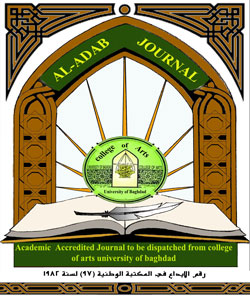Emirati Novel between Origins and Development
DOI:
https://doi.org/10.31973/aj.v1i148.4006Keywords:
the novel, modern Arabic literature, United Arab Emirates, novel trendsAbstract
This research seeks to present research on the modern Emirati novel, whose emergence within the framework of modern Arabic literature was a distinct event, after the entire Arab Gulf region witnessed a wide literary renaissance in culture and development.
The aim of this research was to illuminate this cultural and literary space.
We opened our research with an introduction. In the introduction, we discussed the subject, the reason for choosing it, and the approach followed. We presented a definition of the novel as a literary genre that came to us from the West after the Napoleon campaign, that campaign that initially affected Egypt, then the influences moved to the Arab world.
After that, we divided the research into tow axes:
The first axis we devoted to the topic of the emergence of the Emirati novel, its development, and its trends: the historical, social and feminist trend ... and we separated some of its problems and issues.
As for the second axis, we discussed the subject of the technical elements of the Emirati novel. In it, we talked about the event, personality, time, place and language, all of which are essential elements in the art of the novel.
Downloads
References
إبراهيم، عبد الله. (1988م). البناء الفني لرواية الحرب في العراق. (ط)1. دار الشؤون الثقافية العامة.
إبراهيم، عبد الله. (2011م). التخيل التاريخي. (ط)1. المؤسسة العربية للدراسات والنشر.
أحمد، فاطمة خليفة. (2003م). نشأة الرواية وتطورها في دولة الإمارات العربية المتحدة. (ط)1. منشورات المجمع الثقافي.
آلن، روجر. (1997م). الرواية العربية مقدمة تاريخية ونقدية. (ط)1. المجلس الأعلى للثقافة.
باشلار، غاستون. (1984م). جماليات المكان. (ط)2. المؤسسة الجامعية للدراسات والنشر والتوزيع.
جبور، عبد النور. (1997م). المعجم الأدبي. (ط)1. دار العلم للملايين.
الداديسي، الكبير. (2017م). أزمة الجنس في الرواية العربية بنون النسوة. (ط)1. مؤسسة الرحاب الحديثة.
دراج، فيصل. (2004م). نظرية الرواية تأويل التاريخ. (ط)1. المركز الثقافي العربي.
الرحبي، سيف. (1994م). أهمية المكان في النص الروائي. مجلة نزوى. مؤسسة عمان لصحافة النشر والإعلان.
شواخ، فراس أحمد (2018م). البناء الفني للرواية الإماراتية "رواية من أي شيء خلقت؟" للروائية ميثاء المهيري نموذجًا. رسالة ماجستير غير منشورة، جامعة النيلين، جمهورية السودان.
الشيخ، خليل. (2013م). مناهج النقد الأدبي الحديث. (ط)2. الشركة العربية المتحدة للتسويق والتوريدات.
صالح، مفقودة. (2006م). رواية "زينب" لمحمد حسين هيكل بين التأسيس والتسييس. مجلة العلوم الإنسانية جامعة محمد خيضر بسكرة الجزائر.
طول، محمد. (د.ت). البنية السردية في القصص القرآني. (ط)1. دار المطبوعات الجامعية.
عبد الرحمن، عبد الله محمد. (2008م). مدخل إلى علم الاجتماع. (ط)1. دار المعرفة الجامعية.
عزام، محمد. (1996م). فضاء النص الروائي "مقاربة بنيوية تكوينية في أدب نبيل سليمان". (ط)1. دار الحوار للنشر والتوزيع.
علياء سالم. (1993م). الحرية في أدب الإمارات. مجلة الرافد، العدد الأول. أكتوبر.
العيد، يمنى. (1998م). فن الرواية العربية بين خصوصية الخطاب وتمييز الحكاية. (ط)1. دار الآداب.
القاضي، عبد المنعم زكريا. (2009م). البنية السردية في الرواية "دراسة في ثلاثية خيري شلبي". (ط)1. عين للدراسات والبحوث الإنسانية والاجتماعية.
قصراوي، مها حسن. (2004م). الزمن في الرواية العربية. (ط)1. المؤسسة العامة للدراسات والنشر.
مرتاض، عبد الملك. (1990م). في نظرية الرواية بحث في تقنيات السرد. (ط)1. سلسلة عالم المعرفة.
ملحق الخليج الثقافي. (2012م). الرواية الإمارتية بين الرومانية والواقعية. صحيفة الخليج. 7 أكتوبر.
النعيمي، عبد الله راشد. (2013م). شاهندة. (ط)5. كُتَّاب للنشر والتوزيع.
هنيدي، فاطمة محمد. (2007). إطلالة على تطور الرواية في الإمارات. مجلة دراسات. اتحاد كتَّاب وأدباء الإمارات، العدد التاسع عشر.
وادي، طه. (د.ت). مدخل إلى الرواية العصرية. (ط)2. نهضة مصر.
وهبة، مجدي، المهندس، كامل. (1994م). معجم المصطلحات العربية في اللغة والأدب. (ط)2. مكتبة لبنان.
يقطين، سعيد. (2004م). قضايا الرواية العربية الجديدة. (ط)2. دار الأمان.
يوسف، آمنة. (1997م). تقنيات السرد في النظرية والتطبيق. (ط)1. دار الحوار للنشر والتوزيع.
Downloads
Published
Issue
Section
License
Copyright (c) 2023 رشا عبيد المطروشي، أ.د. عبد الرحمن بوعلي، أ.م.د. ليلى يونس العبيدي

This work is licensed under a Creative Commons Attribution 4.0 International License.
Copyright and Licensing:
For all articles published in Al-Adab journal, copyright is retained by the authors. Articles are licensed under an open access Creative Commons CC BY 4.0 license, meaning that anyone may download and read the paper for free. In addition, the article may be reused and quoted provided that the original published version is cited. These conditions allow for maximum use and exposure of the work.
Reproducing Published Material from other Publishers: It is absolutely essential that authors obtain permission to reproduce any published material (figures, schemes, tables or any extract of a text) which does not fall into the public domain, or for which they do not hold the copyright. Permission should be requested by the authors from the copyrightholder (usually the Publisher, please refer to the imprint of the individual publications to identify the copyrightholder).
Permission is required for: Your own works published by other Publishers and for which you did not retain copyright.
Substantial extracts from anyones' works or a series of works.
Use of Tables, Graphs, Charts, Schemes and Artworks if they are unaltered or slightly modified.
Photographs for which you do not hold copyright.
Permission is not required for: Reconstruction of your own table with data already published elsewhere. Please notice that in this case you must cite the source of the data in the form of either "Data from..." or "Adapted from...".
Reasonably short quotes are considered fair use and therefore do not require permission.
Graphs, Charts, Schemes and Artworks that are completely redrawn by the authors and significantly changed beyond recognition do not require permission.
Obtaining Permission
In order to avoid unnecessary delays in the publication process, you should start obtaining permissions as early as possible. If in any doubt about the copyright, apply for permission. Al-Adab Journal cannot publish material from other publications without permission.
The copyright holder may give you instructions on the form of acknowledgement to be followed; otherwise follow the style: "Reproduced with permission from [author], [book/journal title]; published by [publisher], [year].' at the end of the caption of the Table, Figure or Scheme.











